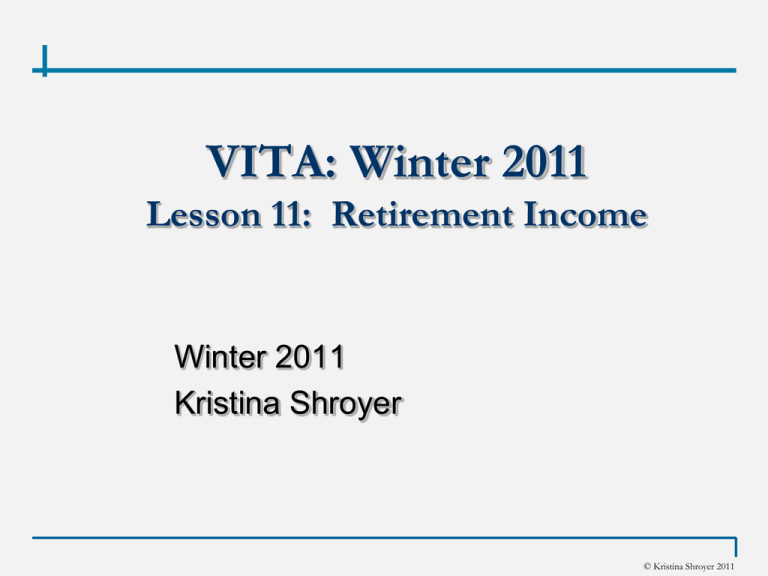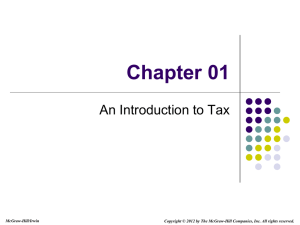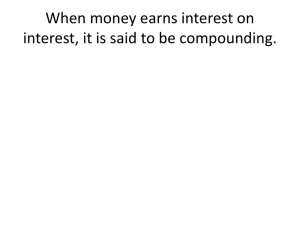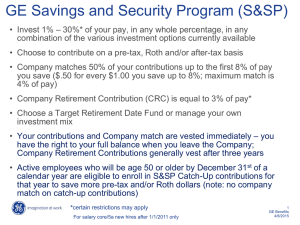Lesson 11 - Retirement Income
advertisement

VITA: Winter 2011 Lesson 11: Retirement Income Winter 2011 Kristina Shroyer © Kristina Shroyer 2011 Lesson 11: Retirement Income Blank Forms for this Lesson As we go through this lesson you'll want to use some of the blank forms in Publication 4491-W for reference (blank forms start on Page 229) Form 1040 (page 229) Form 1099-R (page 81) © Kristina Shroyer 2011 Lesson 11: Retirement Income Introduction What is Retirement Income? In this lesson we're going to talk about retirement income that gets reported on lines 15 and 16 of Form 1040 (Social Security and Railroad retirement benefits will be covered in another lesson) Any benefits from annuities, retirement or profit sharing plans, insurance benefits, IRAs etc. Retirement income may be fully or partially taxable (it's going to depend on if the retirement vehicle was employer or employee funded and if it was funded with pre-tax or post tax income – we'll talk more about that later in the lesson) How is Retirement Income Reported? Retirement income is reported on Form 1099-R - let's take a look at one Line 1 is the Gross Retirement Distribution Line 2a is the Taxable Amount ♦ If the taxable amount is reported here you will see reporting retirement income on the Form 1040 is very easy – this is an intermediate level topic Line 2a may not be filled out and box 2b "Taxable Amount not Determined" may be checked ♦ If this is the case you will have to calculate the taxable amount making the reporting more difficult, as a result this is an advanced level topic © Kristina Shroyer 2011 Lesson 11: Retirement Income How to report Retirement Income if the taxable portion IS calculated The taxable portion of the retirement distribution is calculated if the payer reported an amount on line 2a of Form 1099 R Step 1: If the distribution is an IRA the box next to #7 will be checked ♦ ♦ If the distribution is NOT an IRA (the box is not checked) ♦ ♦ If it has another number in it our a letter it may be in the scope of VITA but a volunteer with an advanced certification needs to prepare the return (we'll talk more about Box 7 later) Step 2: Use line 16a (or 12a on Form 1040A) to report the gross distribution from Box 1 of Form 1099-R Use line 16b (or 12b on Form 1040A) to report the taxable amount of the distribution from Box 2a of Form 1099-R Box 7 should have a 7 for "normal" in it ♦ Use line 15a (or 11a on Form 1040A) to report the gross distribution from Box 1 of Form 1099-R Use line 15b (or 11b on Form 1040A) to report the taxable amount of the distribution from Box 2a of Form 1099-R If there is an amount in Box 4 of Form 1099 (Federal Income Tax Withheld) it should be reported in the Payments Section of the Form 1040 (line 61) HINT on Box 7 Codes: If box 7 has a code in it you need to know what it means, look in the instructions for the 1099-R – Recipient copy (I'll show you on the one I downloaded from the IRS website) © Kristina Shroyer 2011 Lesson 11: Retirement Income How to report Retirement Income if the taxable portion IS NOT calculated Contributions vs. Distributions If the payer did not report an amount on line 2a of Form 1099 R you will need to calculate the taxable portion of the IRA, Pension, or Annuity (this is an Advanced Topic) Contributions are the amounts deposited into a retirement account and Distributions are the amounts withdrawn from a retirement account General Information about Retirement Plan Distributions Retirement plans can be funded by the employee or the employer ♦ Distributions from fully employer funded plans are fully taxable Retirement plans are funded by either before-tax contributions or after-tax contributions ♦ Before-tax Contributions ♦ After-tax Contributions Means the taxpayer did not pay taxes on the money at the time they contributed it to the retirement plan Before Tax Contributions to a retirement plan are fully taxable when distributed (paid out) to the taxpayer Means tax had already been paid on the money at the time the taxpayer contributed to the retirement plan After-tax contributions are partially taxable when distributed (paid out) to the taxpayer There is a chart in your book on page 11-3 that summarizes this Read Example at bottom of page 11-3 © Kristina Shroyer 2011 Lesson 11: Retirement Income How to figure out the taxable portion of IRA distributions (income) 1. Remember IRA distributions are reported on Form 1099-R with box 7 checked There are two types of IRAs that are within the scope of VITA Traditional IRAs Distributions from traditional IRAs are generally taxable because contributions are generally before tax contributions ♦ The exception is when a taxpayer fills out a Form 8606 at the time they make a traditional IRA contribution to indicate that was made with after tax money ♦ Under most circumstances contributions made to traditional IRAs are subtracted from income on the tax return on line 32 (you'll learn about this in detail in Lesson 17) Any distributions a taxpayer received from a traditional IRA they made non deductible contributions to (reported on form 8606) is out of the scope of VITA and the taxpayer should be referred to a professional tax preparer Read Example on Page 11-4 If a taxpayer's distribution is from a traditional IRA and the taxable part is not determined ask them if the contributions to the traditional IRA were deducted from income in the year they were made If the answer is yes the distribution is 100% taxable and use lines 15a and 15b to report it (or lines 11a and 11b on Form 1040A) If the answer is no or sometimes no, this is out of scope of VITA and you should refer the taxpayer to a professional tax preparer © Kristina Shroyer 2011 Lesson 11: Retirement Income How to figure out the taxable portion of IRA distributions (income) 2. Remember IRA distributions are reported on Form 1099-R with box 7 checked There are two types of IRAs that are within the scope of VITA Roth IRAs Contributions to Roth IRAs are made with after-tax contributions and may be excluded from income if all the following requirements are met: 1. 2. The distribution is made after the 5 year period beginning with the first taxable year for which a contribution was made to a Roth IRA set up for the taxpayer AND The distribution is: Made on or after age 59 ½ - OR – Made because the taxpayer was disabled – ORMade to a beneficiary or estate – ORUsed to pay certain qualified homebuyer amounts (up to a $10,000 limit for the taxpayer's lifetime) ♦ IF the two above requirements are not met the Roth IRA could be partially taxable and subject to a 10% penalty – this is out of scope for VITA and should be referred to a professional tax preparer ♦ If the above two requirements are met the Roth IRA distribution is not taxable and does not need reported on the tax return Let's answer Exercises 1-3 at the bottom of page 11-5 © Kristina Shroyer 2011 Lesson 11: Retirement Income How are Traditional IRA rollovers handled? A rollover occurs when a taxpayer gets a distribution from one retirement account (traditional IRA or pension) and transfers that distribution (rolls it over) into another retirement account (traditional IRA or pension) within 60 days of the original distribution When a rollover occurs a 1099-R will be issued to the taxpayer ♦ ♦ ♦ ♦ If it was a direct rollover (from one financial institution directly to another) box 7 will have code G in it If it was not a direct rollover it is up to the taxpayer to have the amount re-deposited into the rollover account within the 60 days (they should give you some sort of documentation) If there is a letter other than G it may not be what you think make sure and research it or ask someone – many of these other letter codes may make the distribution out of scope for VITA If the rollover was not done or not done in time refer the taxpayer to a professional tax preparer To report the rollover (if it is an IRA) report the gross amount on line 15a (11a on form 1040A) and enter $0 on line 15b (11b on form 1040A) and write the word "Rollover" next to line 15b or 11b What about ROTH IRA Rollovers? Generally are handled the same as traditional IRA rollovers, in this case you are looking for code H in Box 7 The rollover MUST be from one ROTH IRA account to another ROTH IRA account (Box 7 will have a code H to indicate this) © Kristina Shroyer 2011 Lesson 11: Retirement Income How to figure out the taxable portion of pensions and annuities? (if box 2a not filled so you must calculate) Box 7 is not checked in this case on Form 1099R indicating this is not an IRA but instead a pension or annuity Fully Taxable Pensions and Annuities Generally Pension and Annuity Income is fully taxable if the following is true: ♦ ♦ ♦ Taxpayers did not pay any part of the cost of their annuities or pensions Employers did not withhold part of the cost of the annuity or pension from the employee's pay – OR Employers withhold part of the cost from the taxpayer's BEFORE-TAX pay while they worked See Example on 11-8 © Kristina Shroyer 2011 Lesson 11: Retirement Income How to figure out the taxable portion of pensions and annuities? (if box 2a not filled so you must calculate) Box 7 is not checked in this case on Form 1099R indicating this is not an IRA but instead a pension or annuity - In addition box 2a is not completed and box 2b is checked Partially Taxable Pensions and Annuities There are two methods used to figure the taxable portion of each pension or annuity payment ♦ ♦ Retirees must use the Simplified Method for annuity payments from a qualified plan unless an exception applies If a taxpayer tells you they have been using the General Rule to figure out the taxable portion in the past this is out of scope of VITA and they should be referred to a professional tax preparer Using the Simplified Method The Simplified Method Worksheet (in the Form 1040 or Form 1040 A Instructions – page 26 – you will need this for the Advanced Test) calculates the taxpayer's cost basis for each monthly payment The number of payments is based on the taxpayer's age on the annuity start date Monthly Tax Free Portion = Taxpayer's cost basis/Number of Monthly Payments Taxwise has a screen to calculate this for you this is the information you need: ♦ ♦ ♦ General Rule (out of scope of VITA) Simplified Method The cost of the plan (box 9b of Form 1099-R) The taxpayer's age on the date the annuity began The total tax free amounts from previous years available from the taxpayer's prior year worksheet (this means unless this is their first distribution you WILL need the prior year tax return If the taxpayer has more than one 1099-R with a pension or annuity that is not fully taxable and has the taxable amount not determined you must calculate each one separately Once you've calculated the taxable portions of the pensions they go on line 16b as usual © Kristina Shroyer 2011 Lesson 11: Retirement Income Look at Question 5 on page 11-8 Disability Pension Income If a taxpayer retires on disability, disability payments are generally taxed as wages (and reported on Form W-2) until the taxpayer reaches the minimum retirement age (which is set by the employer) Once the taxpayer reaches the minimum retirement age disability payments are reported on Form 1099-R and treated like other pension income to determine taxability Retired Public Safety Officers Eligible officers can elect to exclude from income up to $3000 made from a government retirement plan to the provider of accident, health or long term disability insurance ♦ See Publication 575 (Insurance Premiums for Retired Public Safety Officers) © Kristina Shroyer 2011 Lesson 11: Retirement Income Premature (Early) Distributions An early distribution is withdrawal made from a retirement plan for purposes other than retirement by a taxpayer who is under at 59 ½ ♦ If the distribution code in Box 7 of the 1099-R is a 1 that means the distribution was an early distribution with no known exception and is subject to the 10% additional tax ♦ ♦ ♦ ♦ The 10% tax is reported on line 58 of Form 1040 and Form 5329 is not required If the taxpayer meets an exception but the 1099-R was still prepared with a 1 in Box 7 the taxpayer should be referred to a professional tax preparer If the distribution code in Box 7 of the 1099-R us a 2,3, or 4 the taxpayer has met an exception and does not have to pay the additional 10% tax – a Form 5329 is required to show which exception was met ♦ If there is no exception, early distributions are subject to a 10% additional tax, the additional tax applies to the taxable portion of the distribution payment 2—Early distribution, exception applies (under age 59½). 3—Disability. 4—Death. You will cover Form 5329 in detail when we get to Chapter 28 (Other Taxes) Lump Sum Distributions Are out of scope of VITA since they may qualify for special tax treatments You will know it is a lump sum distribution because Box 7 will contain code A (I cannot emphasize how important these codes are) If you're interested in reading about these you can read on page 11-10 © Kristina Shroyer 2011 Lesson 11: Retirement Income Minimum Distributions Taxpayers are required to start taking RMDs (Required Minimum Distributions) from their retirement accounts by a specified date ♦ ♦ After the year the taxpayer is required to start taking an RMD they must receive the minimum distribution by December 31 of that year If a taxpayer does not receive an RMD an additional tax may apply (a 50% excise tax) ♦ Usually the pension company will notify the taxpayer that they need to start taking RMDs Temporary Waiver of minimum distributions for 2009 ♦ The specified date is the year in which the taxpayer either reached age 70 ½ or retired whichever is later These rules do not apply for Roth IRAs For 2009 taxpayers are not required to take an RMD from their IRA or defined contribution plans This applies to participants, beneficiaries and to taxpayers who turned 70 ½ in 2009 and delayed their RMD until 04/01/10 The waiver does not apply to 2008 or 2010 RMDs The penalty is calculated and reported on Form 5329 WAY OUT OF SCOPE This additional tax information is just to help you answer questions if asked Excess IRA Contributions Subject to penalty (6% excise tax), out of scope of VITA More on IRA contributions will be discussed in Chapter 17 Adjustments to Withholding If the taxpayer owes more than $1000 on their federal tax return you want to advise them to adjust their Federal withholding (Box 4) on their Form 1099-R Form W-4P can be filled out and sent to their payer © Kristina Shroyer 2011







